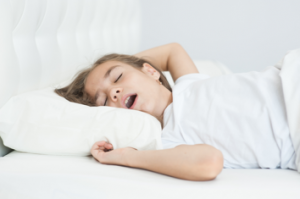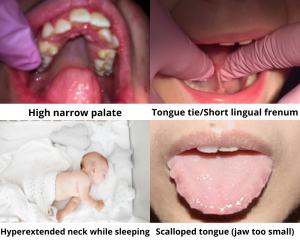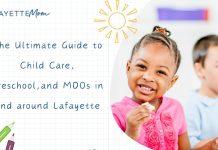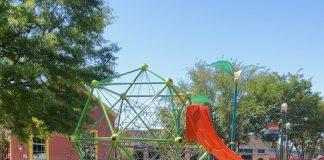Disclosure:: This post is sponsored by Lafayette Pediatric Dentistry and authored by Dr. Anita Gouri.
Sleep Disordered Breathing: More Common Than You Think
“I never knew he wasn’t getting good sleep! He always sleeps SO HARD and I’ve never heard him snore!”
A mother said this to me recently after her son’s routine dental checkup, which revealed distinct signs of sleep disordered breathing. Sleep disordered breathing, a condition which can lead to sleep apnea, is very common in children that often goes undiagnosed. Signs and symptoms of sleep apnea in an adult, such as heavy snoring or “gaps” in breathing, are not always present in children. Children’s sleep architecture is much different than that of adults—they sleep “harder,” remaining asleep through events that could normally wake an adult.
In the case of this particular child, Carter, a healthy 5 year old boy with a clinical diagnosis of ADHD, I noticed during his very first visit that he had enlarged tonsils, a posterior tongue tie, “worn down” teeth from grinding, and a narrow palate. I inquired about his sleep quality, and at first his mother reported that he slept well. I further probed as to whether she noticed frequent tossing and turning, sleep walking or talking, and/or sleeping with his head thrown back. As I was discussing all of this with his mother, I noticed that her son was sitting with his mouth hanging open while playing on her phone. So I also asked her take notice if he consistently breathes through his mouth, even when not congested or sick. 
Within two weeks, she called me back, reporting she noticed that his mouth was almost always open day and night, he slept with his head “thrown back” (with the neck in a hyperextended position), and tossed and turned a lot in his sleep. Though he always remained asleep, mother reported that it looked as though he could never “get comfortable,” and was always readjusting his position. In the mornings, he never seemed fully rested either. I suggested she speak to his pediatrician and request a sleep study. The results lead to Carter being diagnosed with moderate to severe sleep apnea.
His parents were able to take the necessary steps toward resolving this issue, and now 6 months later, they are already reporting a “night and day” difference in his overall quality of life! He has far less trouble sitting still in school, is rested in the mornings, and sleeps more calmly and in a better position at night. Turns out, Carter just wasn’t getting enough air when he slept, and his body was subconsciously trying to do what it could to maximize airflow.
So how do you know if your child is not getting adequate sleep? Here are some oral/facial signs to look for:
- Chronic mouth breathing (mouth usually seen “hanging open,” day or night)
- Heavy breathing like “darth vader” when awake asleep

- Dark circles under eyes
- Teeth grinding (bruxism)
- Chronically enlarged tonsils
- Small jaws, retruded jaw
- Nasal obstruction
- High narrow palate
- Tongue tie/Short lingual frenum
- Hyperextended neck while sleeping
- Scalloped tongue (jaw too small)
Common conditions associated with Sleep Disordered Breathing:
- ADD/ADHD
- Aggressive behavior
- Bed wetting
- Chronic Allergies and Asthma symptoms
- Difficulties in school
- Excessive daytime sleepiness, chronic fatigue
- Frequent nighttime waking/talking/sleepwalking
- Depression/anxiety
- Delayed/stunted growth
- Restless Leg Syndrome
- Obesity
How does sleep disordered breathing cause these issues?
Mouth breathing can be caused by a number of things, most notably a low resting tongue position, nasal obstruction, and/or retruded or small jaws. Mouth breathing fails to purify inhaled air with nitric oxide, like the nose does. Nitric oxide has anti-inflammatory properties and kills dust mites. Lack of nasal breathing may lead to chronic inflammation of the adenoids and tonsils, chronic allergies, and asthmatic symptoms.
 Mouth breathing keeps the mouth and jaws in an open, elongated position, which causes the jaws to narrow as they develop. Narrow, small jaws decrease the overall size of the oral cavity, which leaves no room for the tongue to rest except backwards, towards the airway when asleep. This can lead to partial airway obstruction. When the tongue cannot elevate and rest against the palate as it should, the palate remains narrow, and unshaped by the tongue. As a result, the floor of the nasal cavity also remains narrow and small, leading lack of proper nasal air flow, and frequent congestion.
Mouth breathing keeps the mouth and jaws in an open, elongated position, which causes the jaws to narrow as they develop. Narrow, small jaws decrease the overall size of the oral cavity, which leaves no room for the tongue to rest except backwards, towards the airway when asleep. This can lead to partial airway obstruction. When the tongue cannot elevate and rest against the palate as it should, the palate remains narrow, and unshaped by the tongue. As a result, the floor of the nasal cavity also remains narrow and small, leading lack of proper nasal air flow, and frequent congestion.
When airway or airflow is impaired, the body microarouses itself at night in order to optimize oxygen intake. It is thought that restless movement while sleeping, tooth grinding, bed wetting, sleepwalking/-talking, and frequent nighttime waking are examples of these microarousals. This affects the brain by reducing REM sleep, which can then contribute to excessive daytime fatigue/sleepiness, memory and attention deficits, poor school performance, and development of anxiety or depression. These conditions can have lasting impacts on a child’s growth and development.
90% of the brain develops within the first 5 years of a child’s life, so it is crucial to address sleep disordered breathing as early as possible.
Don’t be afraid to voice your concerns with your child’s doctor. Take notice of sleep patterns as much as possible. Request a sleep study.
If you suspect that your child is experiencing sleep disordered breathing, Lafayette Pediatric Dentistry can help! Call us for more information or to schedule a consultation! 337-981-9242 x1
Website | Facebook | Instagram | Twitter
 About the Author
About the Author
 Dr. Anita Gouri, a pediatric dentist, has been practicing in Lafayette for 10 years and is the owner of Lafayette Pediatric Dentistry. She graduated from LSU School of Dentistry in 2006, receiving honors including Outstanding Achievement in Pediatric Dentistry, Honors in Research, and the Carl A. Baldridge Academic Scholarship. She completed her residency in pediatric dentistry at Children’s National Medical Center in Washington DC in 2008 and became a board certified diplomate of the American Board of Pediatric Dentistry in 2009. In 2010, her research on dental pain assessment was published in Pediatric Dentistry. She also has specialized training in treating babies and children who have tongue and lip ties. She is a member of the Academy of Laser Dentistry, American Academy of Pediatric Dentistry, the Louisiana Dental Association, the Southwestern Society of Pediatric Dentistry, American Dental Association, as well as the C. Edmund Kells and Omicron Kappa Upsilon Dental Honor Societies. Dr. Gouri, her husband, and their two children enjoy travel, Saints football, good food and good friends.
Dr. Anita Gouri, a pediatric dentist, has been practicing in Lafayette for 10 years and is the owner of Lafayette Pediatric Dentistry. She graduated from LSU School of Dentistry in 2006, receiving honors including Outstanding Achievement in Pediatric Dentistry, Honors in Research, and the Carl A. Baldridge Academic Scholarship. She completed her residency in pediatric dentistry at Children’s National Medical Center in Washington DC in 2008 and became a board certified diplomate of the American Board of Pediatric Dentistry in 2009. In 2010, her research on dental pain assessment was published in Pediatric Dentistry. She also has specialized training in treating babies and children who have tongue and lip ties. She is a member of the Academy of Laser Dentistry, American Academy of Pediatric Dentistry, the Louisiana Dental Association, the Southwestern Society of Pediatric Dentistry, American Dental Association, as well as the C. Edmund Kells and Omicron Kappa Upsilon Dental Honor Societies. Dr. Gouri, her husband, and their two children enjoy travel, Saints football, good food and good friends.


















